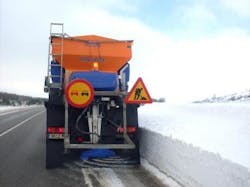Compact optical sensor detects salt on the road to avoid excess salt-spreading
| Compact optical sensor detects salt on the road to avoid excess salt-spreading (Image: Carlos III University) |
Madrid, Spain--Engineers at Carlos III University have designed an optical sensor that detects how much salt is on road surfaces in real time.1 This avoids the need to spread de-icing salt excessively, which can harm vehicles, infrastructure, and the environment.
Cues to spread salt on roads are based on weather forecasts, but do not take into account that the roads can already have enough salt from previous bouts of de-icing.
The optical sensor contains a UV LED to cause sodium chloride (NaCl) salt to fluoresce, and a filter and detector to sense the resulting red fluorescence and decay time.
"The device acts remotely and its compact design makes for easy installation in any road maintenance vehicle," says Marta Ruiz-Llata, one of the researchers.
The research is driven by Alvac S.A., a commercial outfit dedicated to road preservation. The salt sensor is planned to be part of a future system for monitoring road parameters currently being developed by the team.
REFERENCE:
1. Marta Ruiz-Llata et al., Sensors and Actuators B 191, p. 371, 2014. Doi: http://dx.doi.org/10.1016/j.snb.2013.10.009
